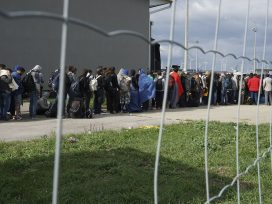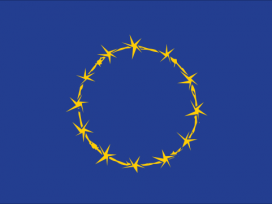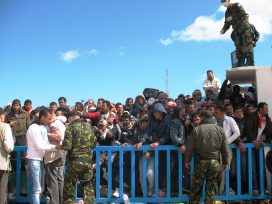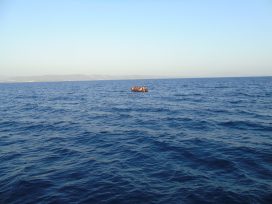Europe is facing the biggest wave of migration since that from the East at the end of World War II and the start of the Cold War. And it is indeed Central Europe, whose peoples regard freedom of movement as the greatest benefit arising from the fall of the Berlin Wall in 1989, where today new migration routes have begun to reveal themselves – along with the tensions that this surge has provoked.
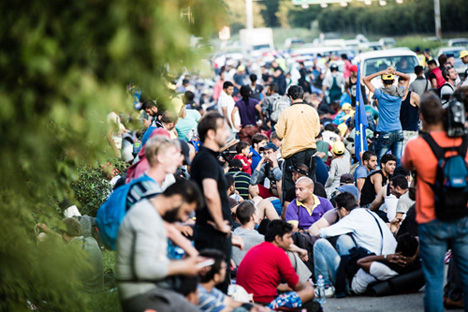
Budapest, 4 September 2015. Photo: International Federation of Red Cross and Red Crescent Societies. Source: Flickr
The country that is the symbol par excellence of the end of the post-1989 era is Hungary. During the summer of 1989, it was the first to open the Iron Curtain between it and Austria, allowing tens of thousands of East Germans who “voted with their feet” to reach the German Federal Republic. In the summer of 2015, Hungary built a 175-kilometre fence along its frontier with Serbia, aiming, with little success, to prevent migrants entering its territory. At the Balkan summit in Vienna, the Serbian prime minister has just declared: “The answer is not building walls. We are just a transit country”. Whereas Hungary claims that it is protecting a European Union frontier, the Serbian foreign minister, Ivica Dacic, allows himself a touch of irony: “The Balkans are facing a wave of migrations from … the EU!” And indeed, the migrants who are arriving in Macedonia and Serbia are coming from Greece, a country that forms part of the EU and is a signatory to the Schengen agreement.
Consequently, we have to distinguish between the “western Balkan” countries and those central European countries that are part of the EU. The former are a source of economic migration, mainly from Albania and Kosovo, but they also constitute a transit zone for refugees from the Middle East heading for the EU (in terms of which there has been 600 per cent increase compared with 2014). The countries of central Europe are attempting to protect themselves against both of these.
Whilst the Serbs have, on the whole, given a sympathetic welcome to the migrants, providing them with food and even with wire-cutters so that they can get through the barbed wire, the central European countries are distinctly more hostile. And not just in Hungary, where only ten per cent of the population are in favour of accepting asylum seekers: eighty per cent of Slovaks and nearly three-quarters of Poles are hostile to receiving migrants, no matter where they are from. All central European governments are hostile to the idea of quotas for sharing out migrants and claim to be ready (in Poland and in Slovakia) to receive a few hundred Christian Syrians. The three Baltic countries have collectively agreed to accept a total of 725 asylum seekers.
So, the first paradox is that those countries, which, after half-a-century of confinement, consider the greatest achievement of the 1989 revolutions to be freedom of movement, now refuse to apply that principle to non-Europeans. Whilst, for twenty years, they have been enthusiastic about globalization (the slogan for the Czech presidency of the EU in 2009 was “Europe without barriers”), today they are calling for a “Europe that protects” (the slogan of the French presidency in 2008).
The second paradox is that, once upon a time, the pro-democracy uprisings in central and eastern Europe that were put down by Moscow gave rise to waves of refugees. More than 200,000 Hungarians fled from the Soviet tanks in 1956 and found a welcome in Austria and subsequently in the rest of Europe to which no one objected. The same occurred with the Czechs and Slovaks after the 1968 invasion and the Poles after 1981, when the repressive regime was bearing down on the Solidarnosc movement. But what now? Is this amnesia or is solidarity supposed to remain solely intra-European?
There are two factors that help us to better understand the situation as seen from the “Other Europe”. Historically, the countries of central and eastern Europe have, since the end of the nineteenth century, been lands of emigration and not immigration. Since 1989, almost one million Poles, Slovaks and citizens of the Baltic States have arrived in the United Kingdom and northern Europe. Romania and Bulgaria have seen about fifteen per cent of their population leave for southern EU countries. But, most importantly, these nations were built on the ruins of multi-national empires (Hapsburg, Ottoman, Russian); they began as nation-states that were nothing of the kind.
Following World War II, during which Hitler had exterminated the Jews and Stalin had encouraged the expulsion of the Germans, we witnessed the simplification of the “ethnic jigsaw puzzle” of middle Europe. Poland and the Czech Republic became homogenous nation-states. Meanwhile, western Europe, with its post-colonial heritage and economic migrations from southern Mediterranean countries, transformed itself from the 1960s onward. Central and eastern Europe experienced the age-old problem of national minorities, whilst western Europe tried to cope with integrating immigrant populations.
This is one of the keys to the current contrast. Whereas, western Europe witnessed a liberal model of multi-ethnic societies being established over nearly half a century, with some variants, eastern Europe experienced closed societies prior to 1989, and has not experienced migrations from the South since, at least not up until now. These nations had been colonized and did not share the West’s postcolonial complex. And, most importantly, there is a very widespread perception in the east of Europe that the western multicultural model is now an abhorrent failure.
There is a pithy phrase that is going the rounds in these societies, and all too often in political discourse and the media, to the effect that “migrations from the South today mean we become suburbs of Islam tomorrow”. To those who make appeals to the duty of providing shelter and solidarity in the name of European humanism, Viktor Orbán replies that he is acting to protect “European civilization”. And the Social Democrat prime minister of Slovakia, Robert Fico, adds: “Slovakia is not bound by any duty. It was not Slovakia that provoked the chaos in Libya by bombing Ghaddafi.”
Europe’s current experience of migration also shows that, whilst the East-West convergence of economies and political systems over a period of twenty years has been spectacular, changes in mentality, reactions to other cultures, views of society constitute a different matter altogether. There are, however, several factors capable of influencing attitudes in central and eastern European countries. These countries are, economically and politically, the most closely tied to Germany, which was the main driver for their integration into the EU and which has this year accepted 800,000 refugees. The firm positions taken by Angela Merkel on acceptance of foreigners and the necessary mobilization of Europeans will have an impact among the political elites of Germany’s neighbours.
In addition, the tensions brought about by the waves of migration from the South have an impact on free movement and settlement of eastern Europeans inside the EU. This can be seen most of all in the United Kingdom, where calls to restrict the immigration of non-EU citizens from the South have become conflated with those to restrict the immigration of EU immigrants from eastern Europe. The EU is realizing that, if it is to have a coherent policy on immigration, it is essential that this should cover the space between Greece and Hungary, that is, the western Balkans: one more step is needed to integrate this intermediate region.
Finally and most important of all, Europe is divided in the face of the implosion of its neighbouring regions: to the south and also to the east, with the crisis in Ukraine and the migration that could ensue. If the countries of central Europe are anxious for Europe to remain committed in the face of threats from its eastern neighbours, they must also agree to play their part in managing the threats from the South.
